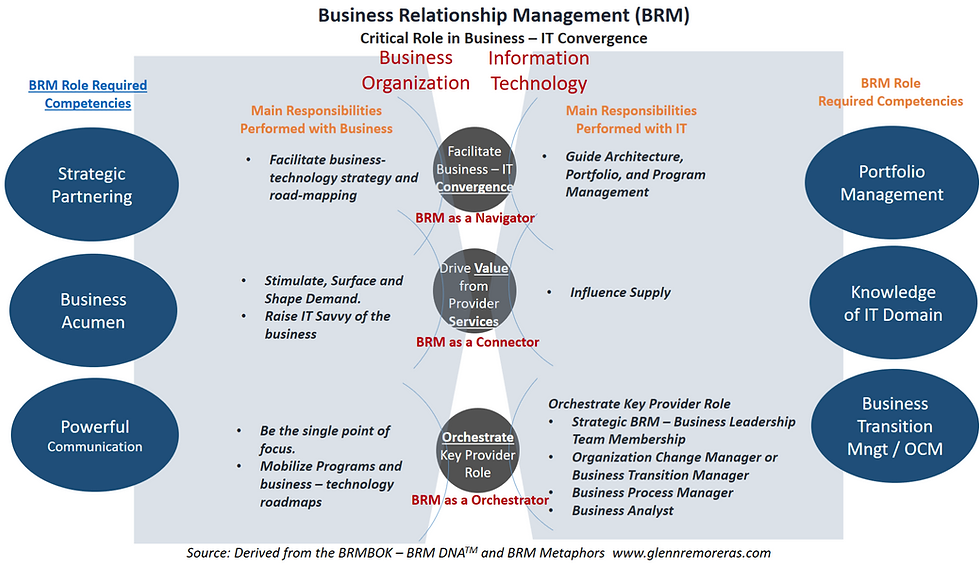Customer-centric IT is the Secret Sauce to Value Creation
- Romeo Siquijor
- Nov 13, 2023
- 4 min read
with Collaboration, Co-design, Co-enablement, and Cultural Considerations as Main Ingredients
In this 3rd installment of the “ABC’s Modern IT Management Amidst the Covid-19 Era”, I will tell you a story about what it meant to be a customer-centric IT. This anecdote is between my good friend, Glenn Remoreras (CIO of Mark Anthony Group), and me back in 1998. Glenn and I have shared many interesting projects, and one of the major highlights we’ve done together is a text-based (Simple Messaging System) mobile selling solution more than 20 years ago. Glenn handled the process side, and I manage the technical architecture side of the house of Cemex IT operations in Asia during those days.
This is an excerpt from Glenn’s blog, “Changing Business Context, Driving Business-IT Convergence.”
“We deployed a website in 2002 so that our customers can order Cement online. We faced major hurdles in convincing our customers to go online to order. One day, I drove with one of our sales representatives and accompanied him on sales visits. It was on one of our interactions with a customer in a small business location that one store owner asked: “Why can’t I just text my cement orders? Why do I have to go online?”. This was the question that led to a simple mobile selling application that we built and deployed later that became more successful than the website. This solution eventually processed around 70% of customer orders. With this crude B2B solution, we also pushed payment reminders to customers and sent warm birthday greetings. As additional context to this successful deployment, during the early 2000s, SMS or Text Messaging became a phenomenon in the Philippines. Literally, everyone was texting. The use of SMS technology became pervasive”.
To continue the story, Glenn and his team approached me to architect the solution. I have always been a maverick in my approach to technological solutions for most people who knew me, as I always favor practicality over high-tech shiny toys. My personal dogma has always been “to use innovation rather than just simply resorting to technology, as technology is just a means to a business end.” The original design standard being pushed globally to enable the solution mandated to Glenn and his team was to use WAP (Wireless Application Protocol). However, given that mobile technology back then relies solely on 2G, WAP was a very impractical and costly solution. I was very vocal and adamant about the use of WAP. So Glenn and I coincided with building our own system — by using a different technological delivery channel but providing the same or better results. We decided to use the SMS (Simple Messaging System) protocol in place of WAP. Applying the “Flash IT” approach to things, I re-purposed some of the GSM (Global System for Mobile communication) modems I have (that I typically use to divert landline phones to cellular phone network to reduce landline-to-mobile phone cost). I interfaced it on a desktop I had under my table. Together with Glenn and his team, we built the prototype, and our system was sending SMS text messages to Cemex Philippines’ customers in two weeks — then the rest is history. While the WAP-based system sits idle, our system sent messages like crazy — all because we listened to our end-customers.
Customer-centric IT is the secret sauce to value creation -- with collaboration, co-design, co-enablement, and cultural considerations as main Ingredients. Work and collaborate diligently with your users and customers. Listening and understanding their requirements will better improve your hit rate in delivering quality IT services and co-creating value for your organization.

On value creation, this is what Glenn has been preaching, “BRM and Virtuous Cycle of Trust Between Business & IT”:
“Value Creation is about business performance and results from a dynamic balance between business demand and IT supply. To succeed, IT organizations need to cultivate a culture of value management. Start by engaging your business partners in clarifying how you can contribute value. Being a good BRM (Business Relationship Manager) means that you have an intimate knowledge of how your company creates value. How does your company make money? What does your company value? How does your company compete? The virtuous cycle of trust between business and IT spins faster when the value is realized and intended outcomes are met. The best way to measure value is by combining two metrics, “time to value” and “value over time.”
For example, one belief that I try to dispel many times at work is that a comprehensive service platform is a prerequisite for creating value. I don’t believe it is necessary to “go big” to achieve anything of value all the time. Sometimes, depending on the business initiative, it can be smarter to start small and act fast. On the other hand, you also have to look at sustainable value over time and balance both. Especially in large investments, value over a long period of time has to be expected”.

[There is a misnomer that what business operators want is what the end-customers always want. Sometimes, it is IT’s or BRM’s role to challenge the assumptions of the business partners and all stakeholders to help them reshape their strategy, then work together towards co-enablement, navigate around all the complexities considering "time to value" and "value over time", then share the risks and rewards.]

ความคิดเห็น